
The Alabama Centennial half dollar, or Alabama half dollar, was a commemorative fifty-cent coin struck by the United States Bureau of the Mint in 1921 as a belated acknowledgement of the 100th anniversary of Alabama's admission to the Union in 1819. The coin was created by Laura Gardin Fraser, the first woman credited with designing a coin.

The Elgin, Illinois, Centennial half dollar was a fifty-cent commemorative coin issued by the United States Bureau of the Mint in 1936, part of the wave of commemoratives authorized by Congress and struck that year. Intended to commemorate the centennial of the founding of Elgin, the piece was designed by local sculptor Trygve Rovelstad. The obverse depicts an idealized head of a pioneer man. The reverse shows a grouping of pioneers, and is based upon a sculptural group that Rovelstad hoped to build as a memorial to those who settled Illinois, but which was not erected in his lifetime.

The Cleveland Centennial half dollar is a commemorative United States half dollar struck at the Philadelphia Mint in 1936 and 1937, though all bear the earlier date. Sometimes known as the Cleveland Centennial Great Lakes Exposition half dollar, it was issued to mark the 100th anniversary of Cleveland, Ohio, as an incorporated city, and in commemoration of the Great Lakes Exposition, held in Cleveland in 1936.

The California Diamond Jubilee half dollar was a United States commemorative silver fifty-cent piece struck at the San Francisco Mint in 1925. It was issued to celebrate the 75th anniversary of California statehood.

The McKinley Birthplace Memorial gold dollar was a commemorative coin struck by the United States Bureau of the Mint in 1916 and 1917, depicting the 25th President of the United States, William McKinley. The coin's obverse was designed by Charles E. Barber, Chief Engraver of the Mint, and the reverse by his assistant, George T. Morgan. As McKinley had appeared on a version of the 1903-dated Louisiana Purchase Exposition dollar, the 1916 release made him the first person to appear on two issues of U.S. coins.

The United States Sesquicentennial coin issue consisted of a commemorative half dollar and quarter eagle struck in 1926 at the Philadelphia Mint for the 150th anniversary of American independence. The obverse of the half dollar features portraits of the first president, George Washington, and the president in 1926, Calvin Coolidge, making it the only American coin to depict a president in his lifetime.
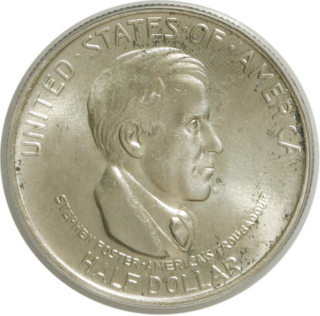
The Cincinnati Musical Center half dollar or Cincinnati Music Center half dollar is a commemorative 50-cent piece struck by the United States Bureau of the Mint in 1936. Produced with the stated purpose of commemorating the fiftieth anniversary of Cincinnati, Ohio, as a center of music, it was conceived by Thomas G. Melish, a coin enthusiast who controlled the group which was allowed to buy the entire issue from the government, and who resold the pieces at high prices.
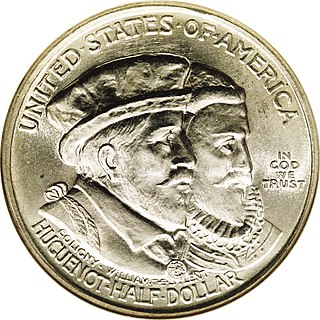
The Huguenot-Walloon half dollar or Huguenot-Walloon Tercentenary half dollar is a commemorative coin issued by the United States Bureau of the Mint in 1924. It marks the 300th anniversary of the voyage of the Nieuw Nederlandt which landed in the New York area in 1624. Many of the passengers were Huguenots from France or Walloons from what is now Belgium; they became early settlers of New York State and the surrounding area.
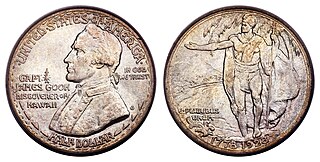
The Hawaii Sesquicentennial half dollar was struck in 1928 by the United States Bureau of the Mint in honor of the 150th anniversary of Captain James Cook's landing in Hawaii, the first European to reach there. The coin depicts Captain Cook on the obverse and a Hawaiian chieftain on the reverse. Only 10,000 were struck for the public, making the coin rare and valuable.

The Pilgrim Tercentenary half dollar or Pilgrim half dollar was a commemorative fifty-cent coin struck by the United States Bureau of the Mint in 1920 and 1921 to mark the 300th anniversary (tercentenary) of the arrival of the Pilgrims in North America. It was designed by Cyrus E. Dallin.

The Maine Centennial half dollar is a commemorative coin struck in 1920 by the United States Bureau of the Mint, in honor of the anniversary of Maine's admission to the Union on March 15, 1820. It was sculpted by Anthony de Francisci, following sketches by artist Harry Cochrane, from Monmouth, Maine.

The Missouri Centennial half dollar is a commemorative fifty-cent piece struck by the United States Mint in 1921. It was designed by Robert Ingersoll Aitken. The US state of Missouri wanted a commemorative coin to mark its centennial that year. Legislation for such a coin passed through Congress without opposition and was signed by President Warren G. Harding on his inauguration day, March 4, 1921. The federal Commission of Fine Arts hired Aitken to design the coin, which depicted Daniel Boone on both sides. The reverse design, showing Boone with a Native American, has been interpreted as symbolizing the displacement of the Indians by white settlers.

The Fort Vancouver Centennial half dollar, sometimes called the Fort Vancouver half dollar, is a commemorative fifty-cent piece struck by the United States Bureau of the Mint in 1925. The coin was designed by Laura Gardin Fraser. Its obverse depicts John McLoughlin, who was in charge of Fort Vancouver from its construction in 1825 until 1846. From there, he effectively ruled the Oregon Country on behalf of the Hudson's Bay Company. The reverse shows an armed frontiersman standing in front of the fort.

The Maryland Tercentenary half dollar was a commemorative fifty-cent piece issued by the United States Bureau of the Mint in 1934. It depicts Cecil Calvert, 2nd Baron Baltimore on the obverse and the Coat of Arms of Maryland on the reverse.

The Hudson, New York, Sesquicentennial half dollar, sometimes called the Hudson Sesquicentennial half dollar, is a commemorative fifty-cent piece struck by the United States Bureau of the Mint in 1935. The coin was designed by Chester Beach. Its obverse depicts the Half Moon, flagship of Henry Hudson, after whom the city of Hudson, New York is named. In addition to showing the ship, the coin displays a version of the Hudson city seal, with Neptune riding a whale, a design that has drawn commentary over the years.
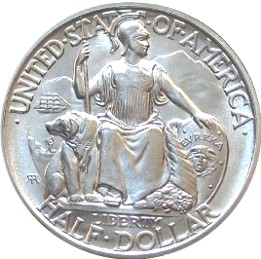
The California Pacific International Exposition half dollar, sometimes called the California Pacific half dollar or the San Diego half dollar, is a commemorative fifty-cent piece struck by the United States Bureau of the Mint in 1935 and 1936. Robert I. Aitken designed the coin. Its obverse depicts Minerva and other elements of the Seal of California; the reverse shows buildings from the California Pacific International Exposition, which the coin was issued to honor.
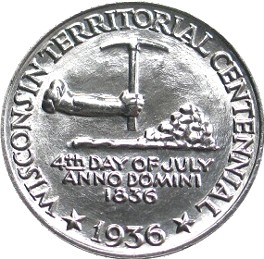
The Wisconsin Territorial Centennial half dollar is a commemorative half dollar designed by David Parsons and Benjamin Hawkins and minted by the United States Bureau of the Mint in 1936. The obverse depicts a pick axe and lead ore, referring to the lead mining in early Wisconsin, while the reverse depicts a badger and the territorial seal.

The Lynchburg Sesquicentennial half dollar was a commemorative half dollar designed by Charles Keck and struck by the United States Bureau of the Mint in 1936, to celebrate the 150th anniversary of the 1786 incorporation of the independent city of Lynchburg, Virginia. The obverse of the coin depicts former Secretary of the Treasury and U.S. Senator Carter Glass, a native of Lynchburg. The reverse depicts a statue of the Goddess of Liberty, with Lynchburg sites behind her, including the Old Courthouse and the city's Confederate monument.

The Delaware Tercentenary half dollar is a commemorative fifty-cent piece struck by the United States Bureau of the Mint to commemorate the 300th anniversary of the first successful European settlement in Delaware. The reverse features the Swedish ship Kalmar Nyckel, which brought early settlers to Delaware, and the obverse depicts Old Swedes Church, which has been described as being the oldest Protestant church in the United States still used as a place of worship. While the coins are dated "1936" on the obverse and the reverse also has the dual date of "1638" and "1938", the coins were actually struck in 1937.
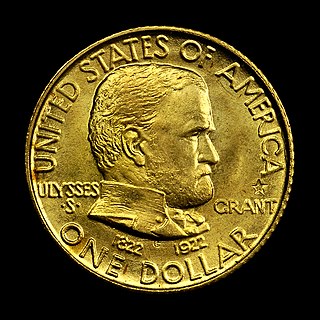
The Grant Memorial coinage are a gold dollar and silver half dollar struck by the United States Bureau of the Mint in 1922 in honor of the 100th anniversary of the birth of Ulysses S. Grant, a leading Union general during the American Civil War and later the 18th president of the United States. The two coins, identical in design and sculpted by Laura Gardin Fraser, portrayed Grant on the obverse and his birthplace in Ohio on the reverse.
























